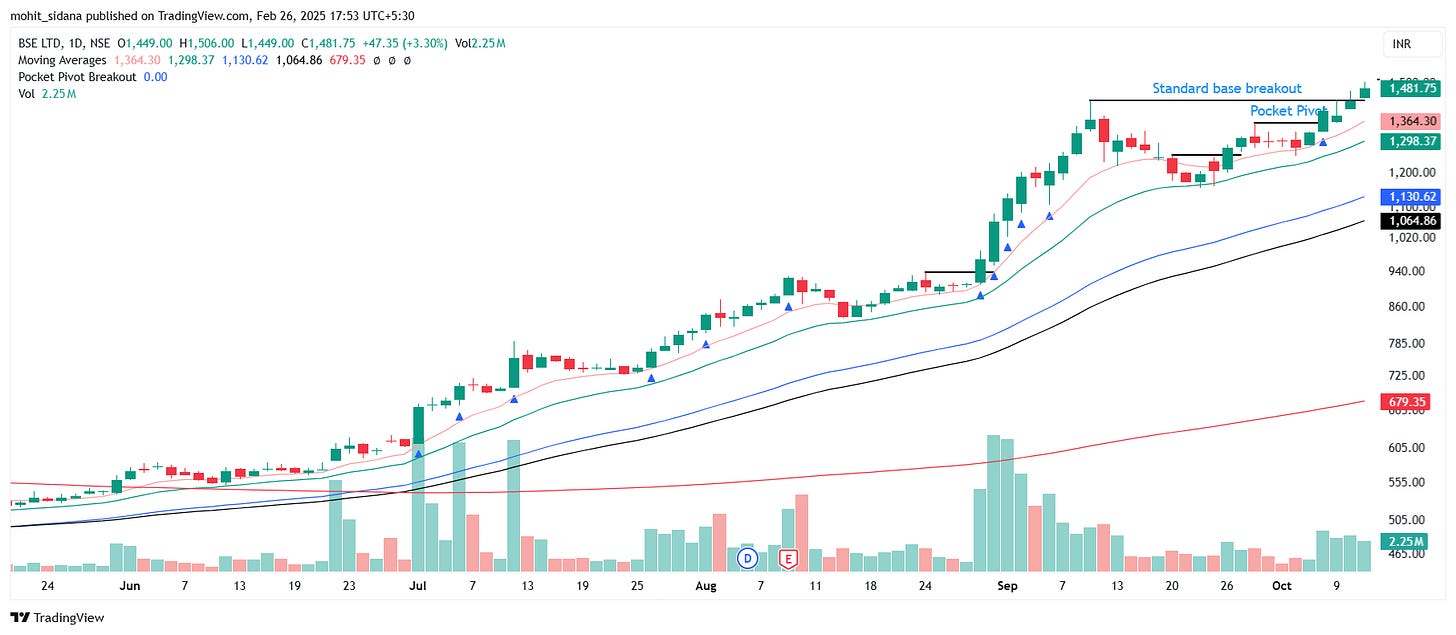Pocket Pivots
Pocket Pivot function as early buy points within a base or as continuation buy points once a stock is extended from a prior base breakout.
The Ten Commandments of Pocket Pivots
As with base breakouts, proper pocket pivots should emerge within or out of constructive basing patterns.
The stocks fundamentals should be strong, i.e., excellent earnings, sales, pre-tax margins, ROE, strong leader in its space, etc. or should have a compelling thematic basis for consideration.
The day's volume should be larger than the highest down volume day over the prior 10 days.
Pocket pivots sometimes coincide with base breakouts or with gap ups. This can be thought of as added upside power should this occur.
If the pocket pivot occurs in an uptrend after the stock has broken out, it should act constructively around its 10 daily moving average. It can undercut its 10-dma as long as it shows resilience by showing volume that is greater than the highest down volume day over the prior 10 days.
Some pocket pivots may occur after the stock is extended from the base. If the pivot occurs right near its 10 daily moving average, it can be bought, otherwise it is extended and should be avoided. Give the 10 daily moving average the chance to catch up to the stock, where the stock would consolidate for a few days, before buying such a pocket pivot.
Do not buy pocket pivots if the overall chart formation is in a multi-month downtrend (5 months or longer). It is best to wait for the rounding part of the base to form before buying.
Do not buy pocket pivots if the stock is under a critical moving average such as the 50 daily moving average or 200 daily moving average. If well under its 50 daily moving average, and getting support near the 200 daily moving average, it can be bought provided the base is constructive.
Do not buy pocket pivots if the stock formed a 'V' where it sells off hard down through the 10 daily moving average or 50 daily moving average then shoots straight back up in a V' formation. Such formations are failure prone.
Avoid buying pocket pivots that occur after wedging patterns.
For more watch this video:
Buyable gap-ups and why they work
A high-quality gap-up is a bullish move where a stock opens much higher than its closing price the previous day, showing intense buying interest.
Why Buyable Gap-Ups Work?
When a stock gaps up on tremendous volume, the "argument" has been won decisively by buyers.
The power or "decisiveness" with which this argument is won is characterized by sharp upside price movement accompanied by a significant increase in trading volume the "signature" of a buyable gap-up.
This same tremendous buying volume is a clear sign of huge institutional buying done with conviction.
Buyable gap-ups are aided by a unique "contrarian" aspect in that most investors don't believe the gap and are afraid to buy it because they think it is "too high."
Gap-ups often act as a support/resistance and are generally not easily breached by stock.
Support:
Resistance:
It gapped down and took time to fill (gap acted as resistance) but when the gap is filled it becomes a very strong tradable setup.
After a gap-up if the stock does not move for six days it is a sell signal.
For more watch this video:
How to use the 10-day and 50-day moving averages in conjunction with Pocket Pivots, Buyable Gap-Ups and other buy points is governed by the "Seven-Week Rule."
10-day → Stocks that have shown a tendency to "obey" or "respect" the 10-day moving average for at least 7 weeks in an uptrend should often be sold once the stock violates the 10-day line.
50-day → If they don't show such a tendency to obey the 10-day moving average then it is better to use the 50-day moving average as your guide for selling.
This rule can prevent you from selling a stock prematurely if its nature is not to hold the 10-day moving average and it tends to drop below the 10-day line often. Our studies indicate that a stock within an uptrend and which is also shown to obey the 10-day moving average for at least 7 weeks following a buy point (e.g., breakout, pocket pivot, buyable gap-up, etc.) should be sold upon its first violation of the 10-day line. A "violation" is defined as a close below the 10-day moving average followed by a move on the next day below the intraday low of the first day.
For more watch:
You can also read these books to understand more about this concepts:















